by Sam Tackeff | Nov 14, 2011 | Baking, Cookies
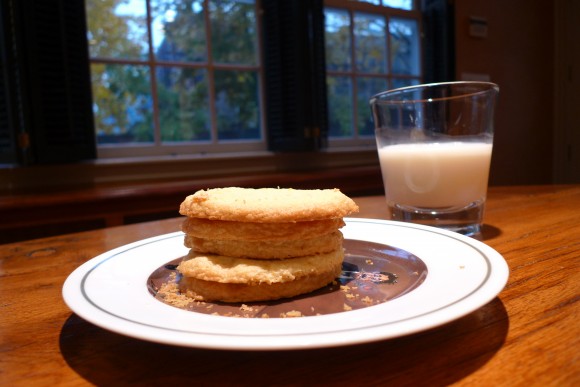
Life Philosophy #734: If not for yourself, bake for others.
I haven’t been baking enough. It’s been a strained relationship with my oven, and the poor appliance has been complaining of neglect.
And worse, I’ve been denying myself of something I really enjoy. I love mixing and stirring and folding and spreading batter in a tin. I love that you can’t tinker forever with your baking – you do the work, pop it in the oven, and then you are done and you must pray and wait.
The real problem is that when I bake, I eat. Ah, but moderation, you say! It’s as simple as moderation! Well, frankly, I’m not very good at moderation. When I bake, I eat and eat and eat, until I’ve finished the entire batch of cookies over a period of an afternoon. Sometimes, I’ll alternate cookies with bites of cheddar to get that elusive sweet and salty combination. Or I rationalize bundt cake for both breakfast and afternoon snack. When I bake, the line between treat and meal becomes blurred, and terrible things happen.
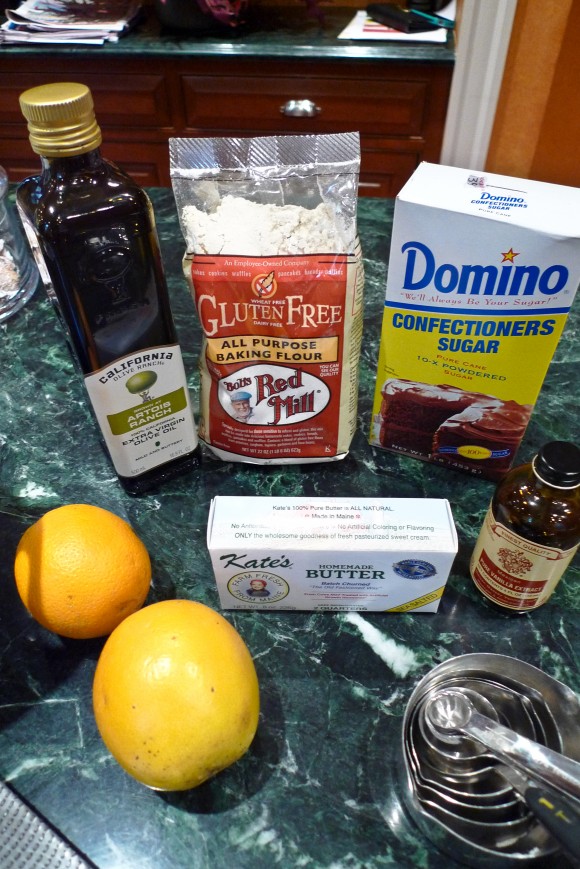
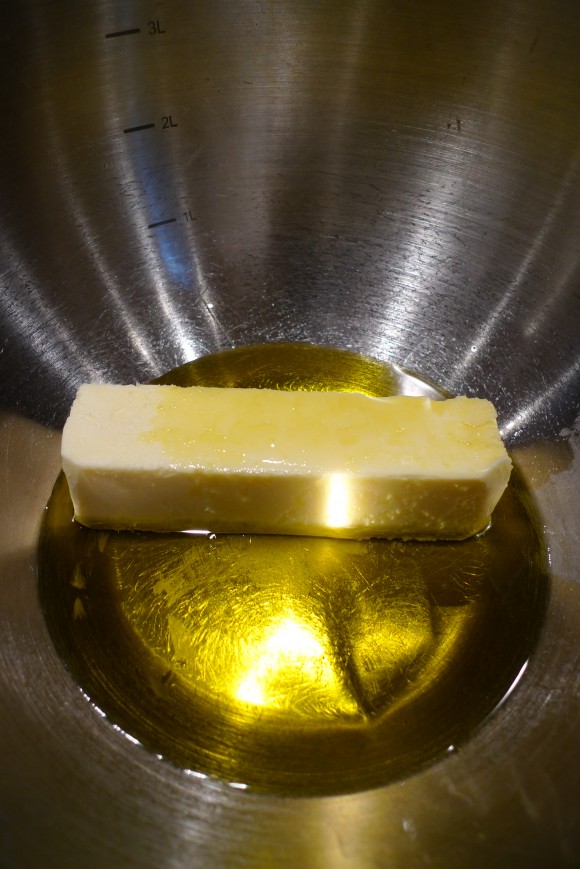
At some point in the past several years, I gave up my love of baking to pursue more health conscious pursuits. Now, instead of cookies, my oven is used for braising or heating up a single frozen biscuit, or maybe some Trader Joe’s Naan. On good days, I may bake an apple and at least get the satisfaction of the smell of warming cinnamon. This restriction has been good for keeping myself on the right track (calorically speaking), but I’ve suffered emotionally. I miss the calming effect of baking, the sweet smells in the kitchen, and the satisfaction when things turn out right.
So with holidays around the corner, and the potential for winter doldrums, I’m going to be back peeking in at rising cookies, cakes, and breads. And I’m just going to give most of what I bake away. If you are a committed eater, let me know, and we can work something out.

I think my plan has been working out pretty splendidly. Last week I made Pumpkin Chocolate Chip Cake. It’s my absolute favorite recipe in the world. I divided the batch into two loaves, and sent one to my brother who is a sophomore at George Mason, the other I brought to Devon’s office in a sort of stealth cake-drop that made people really happy. (I snuck in and left the cake on his desk when they were out of the office). Instead of eating cake for days, I had one slice, and it was delicious.
This week, I decided to make cookies. It was good timing because Bob’s Red Mill and California Olive Ranch had just offered to send me some of their products to bake with. And lord knows I love free baking ingredients. Since I use both of these companies’ products regularly, this was a no brainer.
There are so many delightful things you can bake with olive oil. My favorite flavor pairing is olive oil with citrus. There is something about the sweet citrus that stands up nicely to the sort of spicy, fruitiness of the oil. (This works well in salads, too.) And then you can take the combination a step further, and add almonds, or polenta.
One of my favorite cakes is a recipe from Claudia Roden, made with whole oranges, almonds and olive oil. I’ve love Gina DePalma’s Olive Oil and Polenta Cake, and am desperate to try Niahm Shields’ recipe for ‘little polenta, almond, and blood orange cakes’ in her new book ‘Comfort and Spice‘.
But, this week, instead of a cake (that I’d likely consume in its entirety), I opted to boost my classic shortbread recipe, and play around with citrus, olive oil and polenta. And then do a second round, gluten free. These cookies remind me of Italy, and christmas, and happiness in winter.
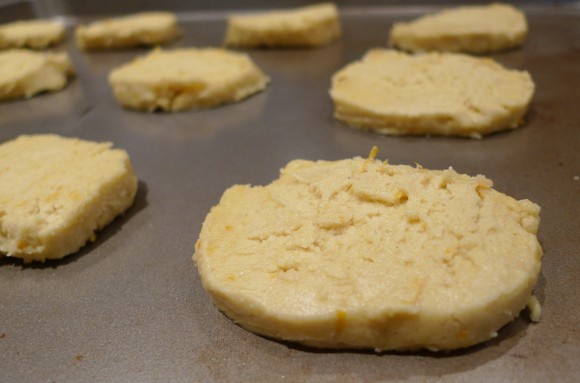
Orange Olive Oil Shortbread
Makes about 2 dozen
I actually made two separate batches of this cookie. The first I used 1 1/2 cups regular AP flour and 1/2 cup cornmeal (polenta) and it resulted in a satisfying crunchy cookie. The second go around I used 2 cups of Bob’s Gluten-Free All Purpose Baking Flour, and omitted the cornmeal. I wanted to see if I could do a good GF version, and was happy to find that it worked out well! The gluten free version was lighter and crispier, but both were pretty splendid.
About the olive oil – you can actually use a pretty robust olive oil, and you’ll get a nice grassy, fruity undertone. Or, if you’d like to tone the olive back a little bit, you can use a more mild and buttery oil. California Olive Ranch sent over the Artois Ranch, which was more mellow for baking, but I’ve also used their Everyday Extra Virgin with great success in cookies.
2 cups all purpose flour (or 1.5 cups + 1/2 cup cornmeal)
a pinch of kosher salt
1 stick unsalted butter, softened
1/2 cup olive oil
1/2 cup powdered sugar
1/2 teaspoon vanilla extract
zest of a small fragrant orange
1. In a bowl, mix flour, cornmeal (if using) and salt, and set aside.
2. In the bowl of a mixer, add olive oil, softened butter and sugar, and beat on medium speed just until just smooth, about 2 minutes. Add vanilla extract, and orange zest, and beat until combined. Set speed of mixer to low. Slowly add flour mixture to the mixer, and beat on a low speed until blended and just coming together. This will be a moist and airy dough, but will firm up enough to cut when put in the freezer.
3. On a piece of parchment on top of a piece of tin foil, form dough into a log and roll up (like a burrito); freeze 1 hour (or up to a month). 10 minutes before taking the dough out of the freezer, preheat the oven to 350 degrees Fahrenheit.
4. Remove shortbread from the freezer and remove parchment. Slice logs into 1/4-inch-thick rounds, and space about 1 inch apart on baking sheets. Bake in the preheated oven until the edges are just slightly golden, about 12 minutes. Let cool to room temperature. (Cooling both allows the cookies to firm up so that they don’t fall apart, and will also help you to avoid burning your mouth on 350 degree butter.)
Cookies can be stored in an airtight container for up to 1 week, but believe me, they won’t last this long. They are also freezable, for up to a month. The bonus when you freeze them is that the butter in the cookie firms up slightly. They taste pretty fantastic frozen, if you ask me.
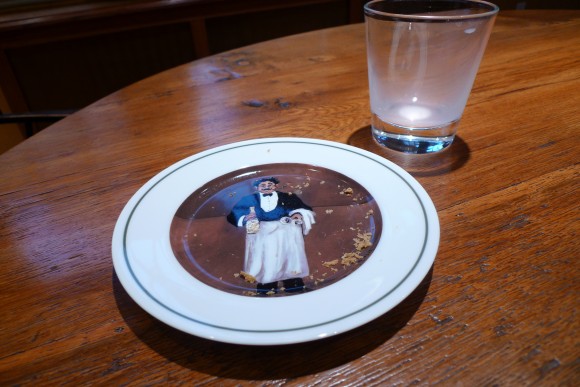
I received complimentary products from Bob’s Red Mill and California Olive Ranch, which were used in the creation of this recipe.
by Sam Tackeff | Oct 25, 2011 | Baking
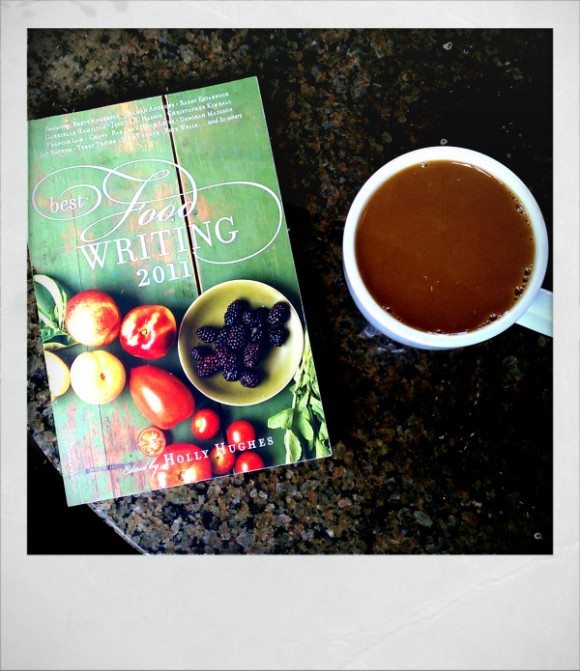
Every morning I wake up and head to the kitchen to put the kettle on. I’m not sure when coffee became part of my morning routine – sometime after I graduated college and settled into my own first kitchen, perhaps – but it quickly became my favorite part of the day, a personal and quiet moment just for me.
I like coffee in the morning because it requires a little bit of careful attention to make a good cup, but nothing I can’t do while still groggy from my deep slumber. There are a bevy of contraptions to use – the coffee machine, the Mukka, the single dripper and filter, but lately I’ve been using my French Press. It makes more coffee than I need, but I get great satisfaction out of pushing down the plunger and separating the grinds from my magic liquid elixir.
There is also ritual in the type of drinking vessel and how you take your coffee. My mom drinks hers black, from the mugs she collects around the world from each city she visits. My dad likes his in the small grey San Francisco mug, with fat free half and half, and several packets of Splenda. I think he’d prefer cream and sugar, but he abstains. I have mugs for different moods: short, round and white with a curved handle, or brown with no handle and a rubber ring you can hold without burning your fingers. I take my coffee too, according to mood – sometimes black to taste the true flavor of the beans, more often with a splash of half and half, or on the days I feel like treating myself, mixed with heavy whipping cream.
Once the coffee is done, I sit down with my mug and a book and begin my morning. Right now my wake-up literature is Best Food Writing 2011, thanks to the kind folks at Da Capo Press. I’ve been reading the collection backwards, and the first story I read, a short piece about Toast by Michael Procopio is in itself worth buying the book for.

On weekends, I sit down with my coffee and some breakfast and my computer, and attempt to plan out my week in food. Usually I surround myself with cookbooks as well, and create lists of breakfasts, lunches and dinners and a few good kitchen projects to get me excited about life.
This week I decided that my kitchen adventure was going to include coffee. This is problematic because I am in a committed relationship with someone who does not like coffee in the least bit, and is happily content living a life without. The only exception he makes is for ice cream, and it has been seasonally cold this week, so I wasn’t too keen on that idea.
But, then, I thought – a trick! What if I put the coffee in pudding? Devon loves pudding in all forms! If I put the coffee in the pudding, he will not be able to resist it. He will eat it even if he doesn’t love the taste, but will be happy because it is pudding, that sweet and creamy manna from heaven! I’m well aware that this logic is selfish, and not very loving, (and will make him grumble when he reads this) but you should see his face when he has just made himself a box of Dr. Oetker’s butterscotch. And home made pudding is always better.
I found a good recipe (see below) and adapted it: my first go around was a chocolate coffee pudding with Kahlua whipped cream. Then I made a second batch, adapting it once more: having tweaked my pudding technique, I made a riff on Turkish coffee – a straight coffee pudding scented with heady cardamom pods.
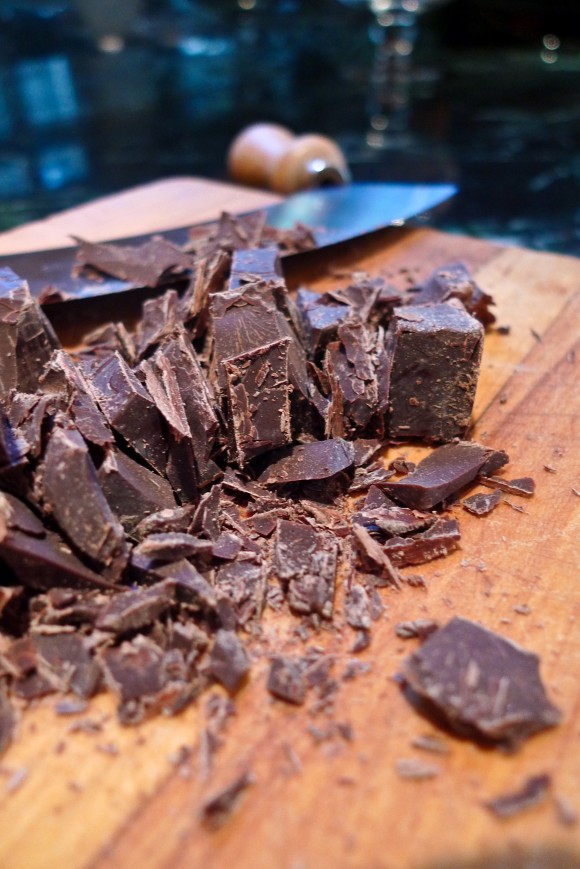
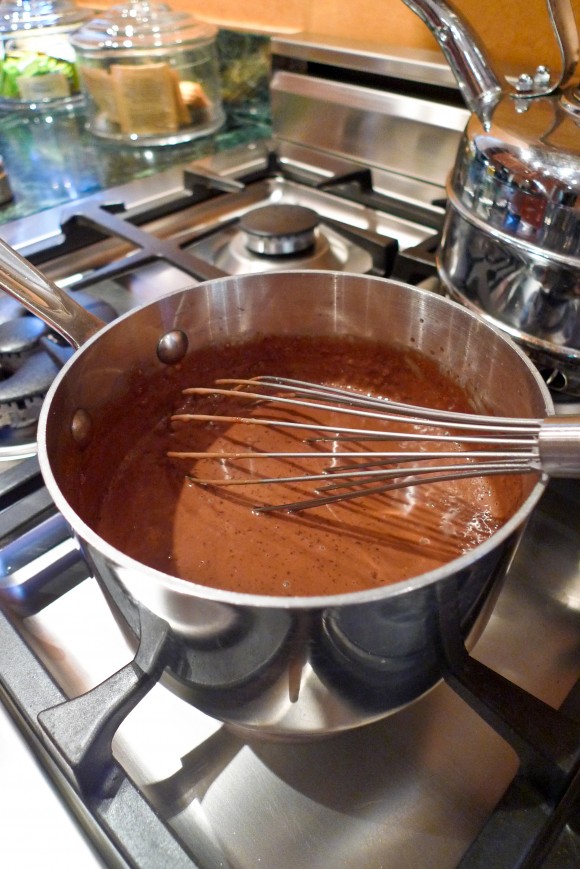
Chocolate Coffee Pudding
makes 4 small cups
(or 3 if you manage to eat a full ½ cup while cooking…)
I noticed this recipe for Coffee Pudding on Not Without Salt about a year ago. I bookmarked it, hoping for some excuse to make a batch. Last week I got a package of Peet’s coffee in the mail from the Foodbuzz tastemaker program, and decided that this was as good a time as any. I adapted it for my taste – a punch of chocolate for my sweet tooth.
1 ½ cups heavy cream (or half and half, but the cream makes it tasty!)
½ cup strongly brewed coffee (or espresso)
2 ounces really good quality semisweet or bittersweet chocolate, in pieces.
2 tablespoons cornstarch
2 tablespoons brown sugar
¼ teaspoon salt
1. In a saucepan over medium heat, stir the cream and the coffee, and the chocolate together with a wooden spoon until it comes to a simmer.
2. In a small bowl, stir together the cornstarch, salt and sugar. Whisk to remove the lumps. (I find a mini-whisk is really useful for this purpose!)
3. As soon as the cream and coffee mixture comes to a simmer, take a few tablespoons of the creamy liquid and add it to the cornstarch mixture to create a slurry; whisk well to combine. Then dump the (now wet) cornstarch slurry back into the warm cream and coffee. Bring to a boil for 1 minute as to activate the cornstarch.
4. If you are intent on the smoothest pudding, pour the pudding through a fine strainer to remove any lumps (I’m usually too lazy to do this). Spoon into four small pudding dishes (or two large coffee cups, if you want to be cute and gluttonous at the same time.) You can cover the surface with plastic wrap if you don’t like skin forming, but I do, so I just cover the cups loosely. Refrigerate until set, at least three hours. Serve with sweetened whipped cream.
Whipped cream note: to make whipped cream, use heavy cream and a little bit of sugar. You can flavor it with a capful of vanilla extract, or in this case, a little rum or even Kahlua works marvelously.
Variation – Coffee Cardamom Pudding: omit the chocolate, and use ¼ cup brown sugar. In the first step, steep 3-5 cardamom pods in the warming cream and coffee. Remove the cardamom when it comes to a simmer, and follow the recipe the same way.

by Sam Tackeff | Oct 13, 2011 | Dinner Parties
Isn’t Jacqueline Kennedy stunning in this photo? That fabulous dress, the pixie haircut and those perfect pearls? It just all seems so effortless.
Being social is something I have to work at. I’m not very good at it. So, I’ve been thinking a lot lately about how to be a better host. One of my dreams for my new home is to host calm little dinner parties for small groups of friends. The ones where you linger over glasses of wine, and stay up past your bedtime telling stories and giggling and feeling warm and cozy. I didn’t do enough of this in San Francisco – sometimes we were too busy or too tired, but too often because hosting makes me anxious.
So lately I’ve been tackling this problem the way I tackle most problems – writing up ridiculous lists in my Moleskin. This one made me chuckle when I looked back at it, so I thought I’d elaborate here. This should really be titled “8 Tips to Stop Being A Hermit, and Socialize, Mkay?” or “How to spend time with people, rather than your DVR”.
Here you go:
#1: Bring on the biscuits. A dinner party does not need to be six guests and a four course meal. A dinner party can be one guest, a meal on the floor. A dinner party can be boxes of Chinese take-out sitting cross legged. Or that ole’ standby, Popeye’s Chicken and Biscuits. You know you are a sucker for those biscuits.
#2: Being Social Good, Being Hermit Bad. It’s a little pathetic that I have to remind myself of this. In college, I liked to take advantage of every opportunity to share a bite to eat with friends. 5pm was cocktail hour with Lizzy, house council meetings had fresh focaccia, and there were always late-night ice cream runs. You’d never head to dining hall to eat a meal alone – the more the merrier.
#3: Channel a Host-Master. My current one is Chez Panisse chef David Tanis – with his underground Paris supper club “aux chiens lunatiques”. If he can invite total strangers over for a meal, I can invite a friend over without stress.
On this note, a few weeks ago, Tara Austen Weaver posted the beginning of a series on how to be a consummate host, in which she shares her ”hosting anxieties”, and interviews those who feel comfortable inviting in the masses. I’m looking forward to reading more of these.
#4: You are not alone, horrified host. My fears and anxieties are shared. There was a study a while back written up in the Telegraph that found that “57 per cent of people found entertaining friends for a meal more nerve-racking than commuting to work, while a quarter said it was more testing than a job interview.” Isn’t that ridiculous? This actually makes me feel a little relieved because I never feel that badly about hosting.
#5: Put away the Alinea Cookbook . I have a terrible habit of spending almost all of my time in the kitchen in experimentation mode. This means that most meals we eat at dinner are only at 75 – 85% of perfection because I’m always trying to fiddle. While it may be tempting for the masochist to pull out the professional cookbook for entertaining, there is no shame in having a good chili recipe that works every time.
#6: Just because your mother uses a set from Shreve’s, your silverware need not match. I’m currently boasting a set of five bowls from Crate and Barrel, white with aubergine inside. My set of “dinner” plates are ones I stole from our house in Maine, vintage green stoneware “snack” plates from the 1950’s with rimmed depressions for the cups that go with them. Literally, plates designed for sitting and eating in front of the television. In the future, I’d love to have a set of beautiful tableware, but as long as the plate is functional, it’ll be just fine.
#7: Put away the bleach, your house need not be sparkling clean. It will never be as clean as it needs to be. Just suck it up, and hope that your friends aren’t jerks.
#8: Stop being boring. See those blank spaces on your iCal? Fill them. You out there, fellow anxious hosts – I implore you, invite someone over next week. Even if it is just for tea, takeout, or a box of Annie’s Shells and Cheddar (although you can do better). The only thing you need to do to have a dinner party is invite someone, just one, and there you go. It is incredibly gratifying to feed people.
After writing out my little list, I felt comfortable enough to invite over my first house guest. Despite the fact that we have no table, one chair, and we are still in the process of painting the kitchen. I made this warm chicken stew, a salad, and strawberries macerated with a little liquor, and some fresh whipped cream. I think it worked out pretty well.
Chicken Cacciatore
serves 4 modestly
with a green salad and some crusty bread
This is one of my favorite recipes adapted from Nigella Lawson for Chicken Cacciatore – she’s a fabulous hostess herself. I’ve actually written about it before, here, but I’ve perked it up a bit. Her addition of beans gives the recipe a little bit more substance. It’s flexible too – you can do it with most pieces of chicken, whatever beans you have on hand, bacon or pancetta or even cubed ham. And, this is one of those nice dishes that you can cook in one pot, and even make in advance of your evening, as it almost always tastes better reheated the next day.
2 Tablespoons Extra Virgin Olive Oil
1 whole clove of garlic
1 white onion, sliced
1 teaspoon fresh rosemary (or 1/4 teaspoon dried)
2 thick strips of smoked applewood bacon, chopped into 1/2 inch pieces
4 whole chicken legs, bone in, with skin (about 2 pounds) or just thighs are fine
1/2 teaspoon celery seed
1/2 cup white wine (or sherry)
1/2 cup chicken stock or water
1 (14 ounce) can of chopped tomatoes
3 bay leaves
1/2 teaspoon sugar
1 (14 ounce) can of cannellini beans
1. Season the chicken with salt and freshly ground black pepper. (Preferably a few hours before if you can). Heat a heavy bottomed pot (I use my Le Creuset) on medium heat.
2. When hot, pour in the olive oil, swirl to coat the bottom of the pot, and place the chicken legs skin side down to brown, about 10 minutes. Turn and cook the other side for about 3 more minutes. Remove, and set aside.
3. Add the bacon and onion and stir until the onion is translucent, about five minutes. Add the whole clove of garlic, the rosemary and bay leaves, and cook for a minute or two, until fragrant.
4. Pour in the white wine, scraping the brown bits from the bottom of the pan (where your flavor is!) Add the can of tomatoes, chicken stock, cannelini beans, sugar, and celery salt. Put the chicken back into the pan, skin side up, cover, and braise for 45 minutes. Remove your bay leaves before serving, as so your guests don’t choke.
by Sam Tackeff | Oct 7, 2011 | Restaurants

I’ve been concentrating these last few weeks on moving in and getting myself situated. This mostly means that I’ve been taking long walks while procrastinating on real work, and identifying my “key snack locations“. Key snack locations are the places I go back to again and again, can have a drink or a very small meal, sit down with a book, or treat myself after suitable exercise. Usually they are noted in miles or minutes from my house, a particular small bite of food that is satisfying, and by appropriate mood. In San Francisco I had several of these: Peasant Pies, (1 mile, Basque Beef hand-pie, standing room for when you just want to grab and go), Samovar (1.5, Masala Chai and Egg Bowl, to stay the afternoon cozily with a book), Tartine (1.5 miles, Almond Rocher and coffee, people watching) or Hapa Ramen (4.5 miles, Fried Chicken Bowl, there is never a bad time for this stuff and you walked far you damn well deserve it).
In addition to the pursuit of gastronomic pleasure, the other reason to identify these places is to give myself somewhere to go when I’m feeling tired or sullen or lonely – which can happen when you don’t work daily in a traditional office. Finding these new places gives me a kick out the door, a good reason to get out of bed in the morning, and a purpose.
So here I am now living in Newton – the ‘burbs of Boston. After staking out the local Starbucks (.3 miles, very large iced tea, reading/re-charging), I’ve been going progressively farther in my exploits, and have even managed to walk to Cambridge and back. I’ve re-visited a few favorites: Sevan Bakery (2.3 miles, cold sour cherry juice and stuffed grape leaves, when in need for Middle Eastern groceries), Formaggio Kitchen (4 miles, cheese samples, good house coffee + poverty inducing groceries, suitable for all moods), L.A. Burdicks (5 miles, single origin hot chocolate, when I’m feeling nostalgic).
And I’ve found a new one: Clover HSQ (5.5, breakfast sandwich, meeting with friends/getting work done). I’m going to tell you about it, because I’ve gone twice in the past week.
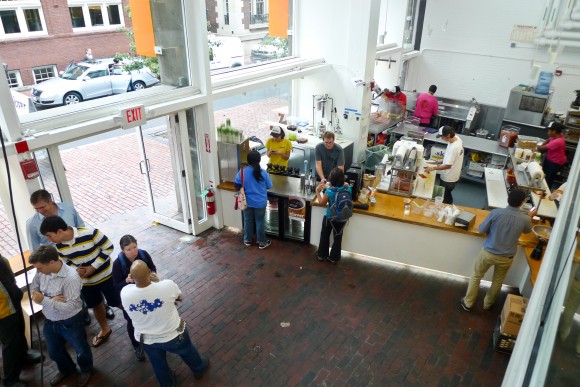
Clover Food Lab is one of those entrepreneurship success stories that made me happy before I even got a chance to try the food. The owner, Ayr Muir, did a great job of documenting the growth of his idea from concept to reality, and I’ve been reading it for a while now. He’s been blogging since the idea was just a seed, and there are hundreds of posts about his successes and failures: branding, licensing, developing each menu item, building the trucks, hiring (and firing) staff, developing a corporate culture, you name it.
What started out as a humble food truck, has since scaled up to several mobile locations and a brick and mortar restaurant. The food is vegetarian (but not boring!), local, and organic when possible. There is a focus on sustainability (everything is compostable), and they care about coffee. I finally made my way out there last week with my good friend Amanda – we were swayed by Clover’s promise of free cider donuts.
“HSQ” as they call the Harvard location is a nice place to sit and stay a while, one of my strongest criteria for a key snack location. The space is bright and airy, and the architecture admirable. In my two trips, I’ve noticed that folks at HSQ are generally in a good mood. When you walk in, things are a little overwhelming, but not uncomfortably so. The open kitchen is on your left, and you see people making real food.
The menu is on your right, on these neat dynamic LCD boards that they custom built, with the menu and approx. time it will take for each item to be made. You order directly from the folks at the front door on their iPhone.

Let’s talk about their coffee, shall we? It’s another one of those important things in my life. I typically only drink a cup a day, so it has to be a good one. At Clover, you get your choice of ordering from one of the different local roasters they have on rotation (I went on a Speedwell day), or a well-regarded national brand that Caf-icionados (did I really just use that word?) will appreciate. This week was Stumptown, but since I’ve had my share of Stumptown already, I opted for the local brew. I got the Guatemalan ($2). My partner-in-crime Amanda got herself the Kenyan* ($2).
After ordering, we grabbed our free donuts, and headed over to the coffee bar to wait for Lucia to make our pour-overs. It’s been hard for me to get used to non-SF-style coffee pouring, but Clover actually makes a good case for not weighing/no bloom/no spiral pouring on their blog. Despite having read this short manifesto in advance, I had to ward off the anxiety that comes from shattering my San Francisco-coffee-indoctrination ideals. The fellow standing next Lucia (and grinding the beans to order) was actually from the local roaster and calmed me with his coffee knowledge, and despite desperately missing the calming concentric spiral pouring I’m used to – the coffee was fantastic. You can’t argue with good tasting results.
{*A brief note about this Kenyan. Maybe it was some sort of interaction with the cider donut, but I swear smelled and tasted like weed. Yes, a cup of coffee with the aroma of marijuana. It might have been some crazy olfactory thing going on and was truly bizarre.}
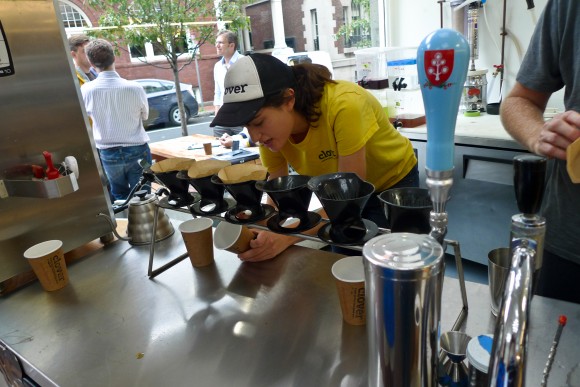
We headed upstairs to sit in their little alcove area and people watch. It’s a little unusual for me to be in an establishment like this without my laptop, but I’ve been learning to wean myself off of it and actually meet up with people again. Upstairs, they grow fresh herbs in a planter that they built themselves.
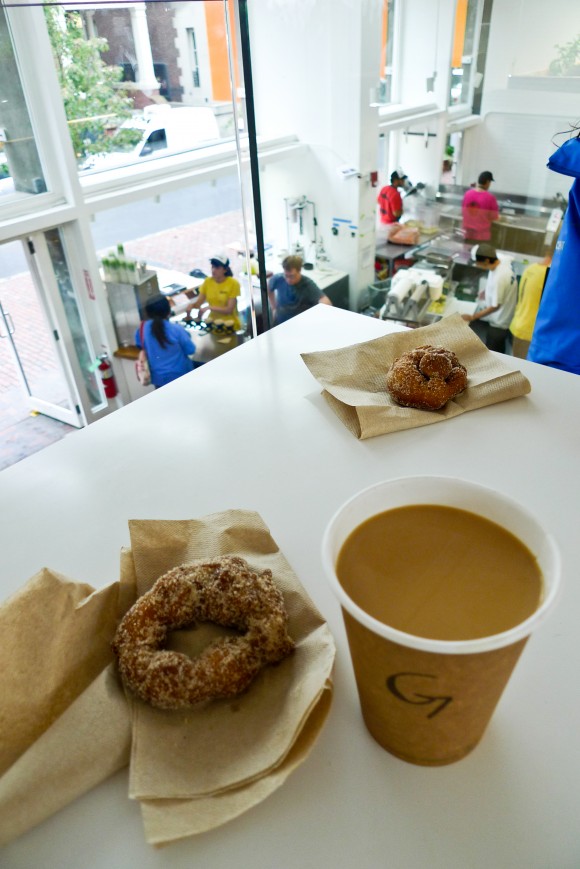

We inhaled the free donuts (more about that in a second), and after my sweet fix, I started craving real breakfast. The curse of treating yourself to wholesome morning food on a regular basis?
As we were there before 10:30 am, it was too early for the chickpea fritter (their version of falafel) and the barbecue seitan – although they make their seitan themselves, from scratch. I may have offended one of the staff by saying that the marinating seitan looked an awful lot like tripe. But they were totally nice about it.
I opted for the breakfast sandwich ($3). Soft whole wheat pita, a slice of ripe tomato which they season, cheddar cheese, and a soft cooked egg. I’ve been burned lately on one two many spongy egg breakfast sandwiches, but in this sandwich I found the antidote. The way this egg was cooked and the yoke oozed into the pita made me swoon. This egg was the key snack location clincher.
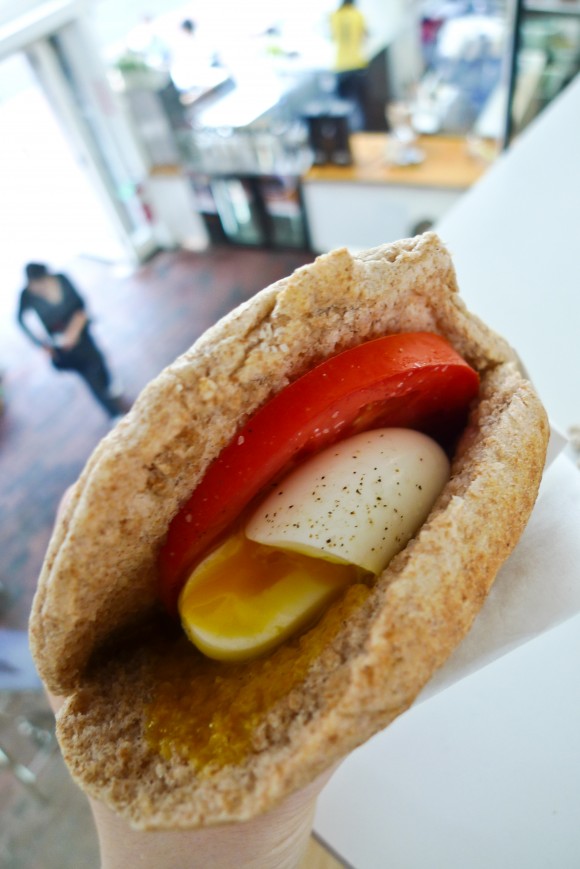

But back to the donuts. These aren’t every day fare at Clover, they are treats, and that’s part of the deal – they don’t have daily desserts because you shouldn’t be eating the sweet stuff at every meal. Instead, on certain occasions like this one, they have special things – free cupcakes for a staff member’s birthday, or Whoopie Fridays. (Apparently, customers have complained, but I think the idea awesome.)
Cider donuts are a New England staple, and I grew up inhaling the ones from Applecrest farm. These, I’m a little ashamed to admit, were better than Applecrest. {May the hometown gods not smite me.}
The batter was not too sweet, a little spicy, and the donuts had a generously sugared exterior. The texture was soft but cake-like on the inside, and a little crispy on the outside. The best part of these donuts? Salt. Enough to cut through the sugar and make for a really well balanced and satisfying bite. I went back for another one before heading out the door, because there were no guilt-trip signs telling me to limit my consumption to one.

And three days later? I was back for the Chickpea Fritter ($5).
When I see things like this on a menu, I don’t expect much – as a Jewish and Middle Eastern girl I’ve had my share of superior falafel, and have impossibly high standards. But my friend Amanda recommended it, and I trust her judgment. And after sinking my teeth into it? It’s good. Really good. More of the soft pita, fried chickpea balls that taste like chickpeas and aren’t oily have a crunchy exterior and a soft center, and plenty of pickled onions, shredded carrots and cabbage, cucumber and tomato salad, all topped with a good dousing of both hummus and tahine. Oo! And some cucumber pickles too – a nice touch.
Plus, the thing is less than 500 calories (they post nutritionals every so often on the site), and enough food to keep you full for a good long time.
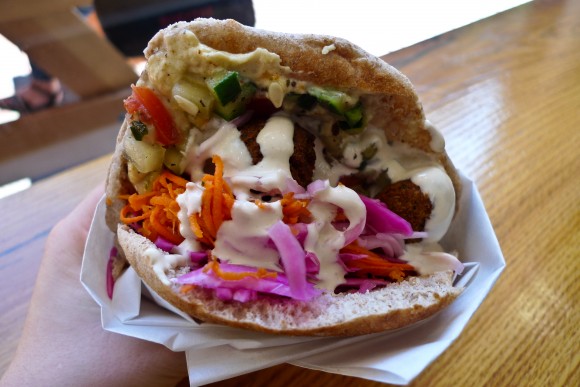
In short? This place is definitely going to go into heavy rotation.
What about you? What are your Key Snack Locations? Snack Criteria? And Boston Folks, where should I go next?
Clover7 Holyoke St
Cambridge, MA
02138

by Sam Tackeff | Sep 30, 2011 | Blogging

Some musings, this afternoon, on the ethics of food blogging.
Dianne Jacob, author of “Will Write For Food” (the book anyone interested in food writing should own), posted a piece this week entitled “5 Ways Bloggers Changed Restaurant Reviewing“. In the wake of Sam Sifton stepping down from his post as reviewer at the NYTimes, she observes a shift in restaurant/reviewer dynamics (both positive and negative) that she attributes to food bloggers. What are food bloggers doing differently?
According to Dianne: “Food bloggers don’t wait to review. Restaurants have opening events for bloggers. Bloggers are more likely to cover an event than to review the food. Blog write-ups are more positive than print reviews. Bloggers celebrate all kinds of restaurants, not just fine dining.”
Before I comment, I want to say that Dianne’s posts are always thought provoking. Usually I agree with her, but even when I don’t I appreciate her clarity, opinion, and commitment to discourse. (She’s also brilliant at responding to comments.) In this case, I agree that a shift has occurred but I’m not sure to what degree these generalizations about food bloggers are the cause. I’m pretty sure that Sifton didn’t step down because of Yelpers and bloggers. But, the piece did make me question my role in the shift.
As queen of my small corner of the internet, The Second Lunch, am I a culprit? Do I commit blogging sins? Ethical blunders? Have I unintentionally axed Sifton when I write about Ma Po Tofu in Belmont?
I like to eat out, and I like to write about my experiences. Writing about a good experience extends the pleasure of the event, and is in itself a little hedonistic. Nobody pays me to write about bad experiences – so I usually don’t – but I recognize this is probably a mistake on my part. Some of my favorite pieces by other writers are negative reviews. Writing honest distaste is a craft in itself.
For a long time, I avoided writing about any restaurants or products because I didn’t want to offend anyone. I wasn’t sure that it was “fair” to write about something that I’ve only experienced once or twice, and frankly, I didn’t want to get un-invited to a future event because of a negative slant in my posts. I used to be much more snarky on my personal blog, and I’ve held myself back in this slightly more public space by an invisible standard I’ve been trying to set here. An erroneous standard, I believe. Why should I be afraid of my experiences swaying an audience? Some people are more critical in print than they are in person. I’m the opposite. I’m never afraid to speak my mind to someone in person. (My closest friends are chuckling at the understatement.) Now, people who I’ve never met read this blog. I know they do, because somewhere along the line I started obsessively checking my Google Analytics and Feedburner, sigh. As more people started reading, I committed a sin: I tried to be someone I’m not. I held back because I was afraid. I denied myself the experience of writing because I didn’t want to offend anyone by being myself. Yes, I understand this is counter-intuitive. And it made for some terribly boring writing.
Which brings me to my first goal in this space: becoming a better writer. What makes a good writer? Practice. Let’s face it, I don’t have the time or financial assets to practice writing traditional print-style reviews. And in order to become a good writer, you have to write what you know. So sometimes this means that I write about a place that just opened, or an event that I’ve been invited to. I’d love to write about my meal at Per Se, but I can’t afford that. I’d love to write long form pieces, but a blog isn’t really the ideal space to write 3000 words. So I write about my little experiences. I could write these pieces and file them away for thirty years, or rip them up because they aren’t good enough, but the internet allows me to self-publish. Publishing here motivates me to work harder at my writing.
My second goal? Being part of a community. I’m not sure that someone who publishes reviews of restaurants in a major publication feels the same sense of community as those who write (and read) food blogs. Traditional media has long relegated the writer to a lonely position. The Dining & Wine section doesn’t offer space for comments. When I write a post, I’d like to think that I’m offering a reader an opportunity to live vicariously and encouraging discussion. I like reading and responding to comments. I like the conversation that spills off the blogs and onto Twitter. I like the fact that I’ve met so many people because of this space.
As a part of the community, I feel obligation to both my readership and society at large. I was interested to read one of Dianne’s responses in the comments of her post: “If your sympathy is on the side of the restaurant, you are not representing your readers.” While I agree that traditional reviewing requires you to be on the side of the reader, as a blogger I also have a relationship to the food world in its entirety, including restaurant owners, chefs, authors, etc.
Who am I writing for? Unlike a traditional reviewer, I’m writing for myself as much as (and sometimes more than) I’m writing for a reader. My blog is a place for self-discovery.
What about anonymity? I’m not anonymous, because I want to interact with members of the community. I want to learn. When I take photos, I’m taking them for myself and for my readers. I understand ethics, and reasons why one might want to conduct an anonymous review, but I submit that so many people have the desire to share things publicly now that a blogger wielding a fancy DSLR will rarely affect the quality of the meal. Bloggers are now required by law to disclose freebies, and I when I read about a free meal a blogger received, I take that into account – just as I take into account the fact that a professional reviewer is often being paid to eat at a restaurant, and doesn’t feel the sting as much as someone who has to shell out the cash on their own. (Although this is changing as more print-media reviewers are seeing major budget cuts).
Accepting freebies? A few years ago I was at a dinner with Dianne (same one!) and her husband Owen. Owen worked as a professional technology reviewer, and told me (to my surprise) that reviewers must return test products as part of an ethical standard. I think this is changing. I don’t find it to be an ethical conundrum to accept free products. I just don’t.
And how about other food bloggers influencing my actions? The bloggers who intrigue me are the ones who don’t gush, who write thoughtful pieces, and who seek a wide variety of personal experiences. As a reader, I’m wary of those who constantly shill for free products and PR events, but I don’t discount them automatically because they accepted something free. You read enough crap and you very quickly learn to skip over the fluff, and seek out the good stuff. Earlier this week Jen at Tiny Urban Kitchen put up a mini-review of Clover, a restaurant in Harvard Square I’ve been meaning to try. The review wasn’t glowing, but it was positive. The photos were excellent (most in-print publications can’t afford to have so many high quality photos in their articles). When my friend Amanda texted me at 8:30 in the morning letting me know that there were *free cider donuts* at Clover I sprinted out of bed. A blogger had planted the seed, and yes, I succumbed to a freebie.
I’d love to hear your thoughts in the comments, but keep it civil please! I don’t want to have to reach out from my sovereign territory and hit someone with a stick. But I can! Because I’m a blogger!
So my questions for you: a) Do you write about restaurants? Why? Are you “reviewing”? b) Do you accept freebies? Have any qualms? c) Who are you writing for?

























